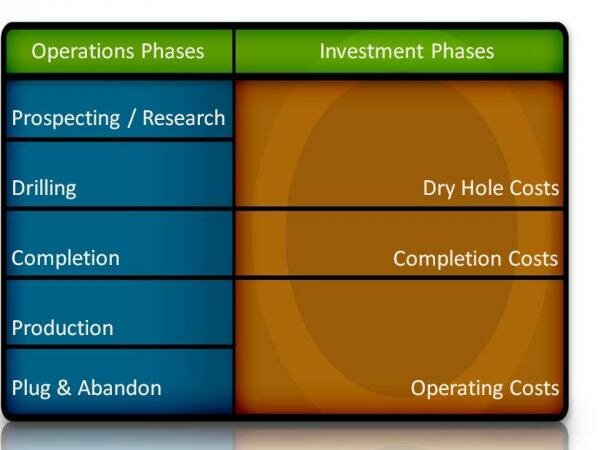Education Center
Welcome to Gulf Coast Midwest Energy Partners' oil and gas education center. Our education center was built to assist our partners in learning more about the basics of oil and gas operations, the business and how we approach investing and risk management. In addition to covering the operations of drilling and completing an oil and gas well below, there are five more links above that cover additional topic areas. There are even more education center topics available to our investing partners inside covering more aspects of the business. Gulf Coast's investment partners can truly participate in the business with the knowledge of the key drivers and risks of the business and how we manage them.
Oil and Gas Well Operations
Every successful oil and gas well experiences five phases of operation and two major investment phases in addition to ongoing operating costs.

Prior to drilling a well, the participants sign an AFE (Authorization for Expenditure). The AFE represents a budget for the two investment phases; dry hole costs and completion costs for the well.
Dry hole costs represent roughly two-thirds or more of total well costs and are always incurred. Completion costs are only incurred if the well tests positive for hydrocarbons.
Educational Links & Animations
Educational Link: How are oil wells drilled? - An overview of operations from "howstuffworks".
Drilling and Operations Phrases
Every successfully drilled oil and gas well has a discrete set of phases in its operating life. Following is a broad description of the basic steps involved and drilling and producing an oil or gas well:
Location Preparation Activities
Clear and level the land.
Build access roads if necessary.
Hook up to a water source. This would generally include drilling a water well.
Dig and line mud pit. Lining the mud pit prevents drilling fluids, which carry cuttings up the wellbore as the well gets drilled, from entering the ground water table.
Drill several holes to prepare the site to accommodate the larger drilling rig that will be brought in to drill the oil or gas well. These include:
- Cellar - Location for blow out preventer. Captures drilling fluids and drainage water. 5' to 10' deep and wide.
- Conductor - Hole drilled from cellar to as deep as 90'. This is the starter hole for the larger drilling rig and is where surface casing is set.
- Mouse hole - Holds next stem of drill pipe.
- Rat Hole - Stores the "kelly" when the drill pipe is being hoisted out of the hole.
Rig Up
Build the drilling rig. Each rig and its related equipment is transported to the site on between 35 and 45 semi-trailers.
Drilling
Drill a hole 5 to 30 inches in diameter. Wells can be vertical, directionally drilled or even lateral.
Drill collars, above the drill bit, aid the process by weighting down the bit as it breaks up the earth.
Drilling mud is pumped down the inside of the drill pipe. It helps break up the rock, keeps pressure on top of the bit and cools and lubricates the drill bit.
Setting Casing - Steel pipe (casing) slightly smaller than the original hole is secured in the hole with cement. Casing provides structural integrity to the wellbore. Depending on the depth and down-hole pressure in the well, there can be more than one (as many as five) string of pipe utilized. The majority of wells drilled by Gulf Coast Midwest utilize only one string of pipe.
After drilling the well to its required total depth, it is logged or tested for hydrocarbons. If the well tests productive, it is completed. If not, it is plugged and abandoned.
Completion
Cased Hole Completion - Small holes called perforations are made in the portion of the casing which passed through the zone or zones that logged or tested productive.
Open Hole Completion - Gravel pack or sand screens may be installed in the last drilled, uncased reservoir section. They provide structural integrity and prevent formation sand / debris from migrating into production tubing and equipment.
The operator can complete one or more zones at the same time depending on geological circumstances. It is important to note that the completion of successful wells, in most cases, has a distinct process. The operator will complete productive zones in order; from the deepest productive zone to the shallowest.
Acids or fracturing fluids are pumped into the well. These fluids may include proppants that help keep the formation open. There are many different completion techniques. They vary depending on each formation's characteristics.
Set a packer in the area above the reservoir section of the well.
Set production tubing.
Install additional equipment, if necessary that aids production flow if the down-hole pressure is not enough to push the oil and gas to the surface. These may include down-hole pumps, lifts, or surface pump jacks and other equipment.
Production
Hydrocarbons flow from the Christmas Tree and are connected to a distribution network of pipelines (natural gas) and tanks (oil & water).
In some states, a disposal well can be used to dispose of water.
Plugging and Abandonment
Remove production tubing from the well. If the well was never produced, this would not be required.
Fill sections of the well bore with cement to isolate the flow path between gas and water zones from each other.



